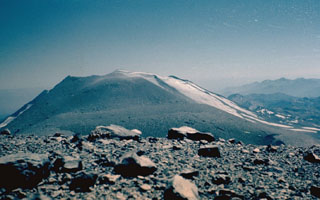Report on Nevados de Chillan (Chile) — 5 October-11 October 2022
Smithsonian Institution / US Geological Survey
Weekly Volcanic Activity Report, 5 October-11 October 2022
Managing Editor: Sally Sennert.
Please cite this report as:
Global Volcanism Program, 2022. Report on Nevados de Chillan (Chile) (Sennert, S, ed.). Weekly Volcanic Activity Report, 5 October-11 October 2022. Smithsonian Institution and US Geological Survey.
Nevados de Chillan
Chile
36.868°S, 71.378°W; summit elev. 3180 m
All times are local (unless otherwise noted)
SERNAGEOMIN reported continuing activity at Nevados de Chillán during 16 September-11 October. Dome 4 in Nicanor Crater grew until mid-September, coincident with thermal anomalies seen in satellite images, which decreased and were not present during the second half of the month. Explosions during 16-30 September and into early October produced ash plumes that generally rose no higher than 1 km above the crater rim. Notably, an explosion on 19 September produced an ash plume that rose 1.1 km and drifted SE, and ejected blocks 500 m from the crater rim. An incandescent ash plume from a second explosion rose 1.7 km and drifted SE, causing ashfall on that flank. The explosions that day partially destroyed the dome.
At 1906 on 8 October a long-period earthquake signal was followed by an ash plume that rose 1.7 km and drifted NNE. An explosion at 1926 on October generated a dense ash plume that rose 2.5 km and drifted NNW. Pyroclastic flows traveled short distances down the NNW flank. The Alert Level remained at Yellow, the second lowest level on a four-color scale. Sistema Nacional de Prevención y Respuesta ante Desastres (SINAPRED) maintained an Alert Level Yellow (the middle level on a three-color scale) for the communities of Pinto and Coihueco, and reminded residents not to approach the crater within 2 km.
Geological Summary. The compound volcano of Nevados de Chillán is one of the most active of the Central Andes. Three late-Pleistocene to Holocene stratovolcanoes were constructed along a NNW-SSE line within three nested Pleistocene calderas, which produced ignimbrite sheets extending more than 100 km into the Central Depression of Chile. The dominantly andesitic Cerro Blanco (Volcán Nevado) stratovolcano is located at the NW end of the massif. Volcán Viejo (Volcán Chillán), which was the main active vent during the 17th-19th centuries, occupies the SE end. The Volcán Nuevo lava-dome complex formed during 1906-1945 on the NW flank of Viejo. The Volcán Arrau dome complex was then constructed on the SE side of Volcán Nuevo between 1973 and 1986, and eventually exceeded its height. Smaller domes or cones are present in the 5-km valley between the two major edifices.
Sources: Servicio Nacional de Geología y Minería (SERNAGEOMIN), Oficina Nacional de Emergencia-Ministerio del Interior (ONEMI)

